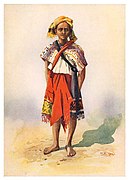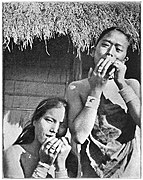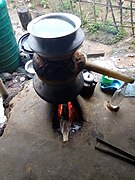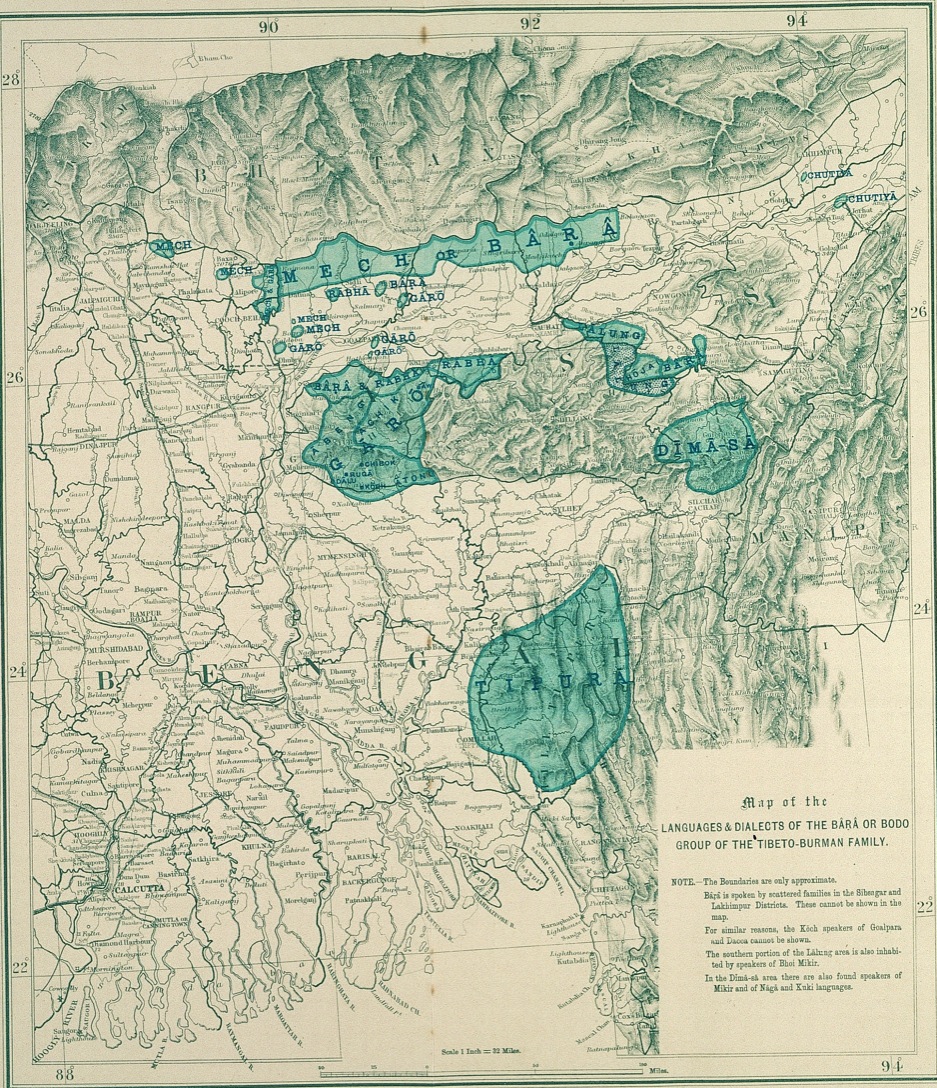Boro people
Thank you for being part of the Bharatpedia family! 0% transparency: ₹0 raised out of ₹100,000 (0 supporter) |
Boro, Kachari | |
|---|---|
 Boro bwisagu dance in traditional attire | |
| Total population | |
| 1.45 million[1] (2011) | |
| Regions with significant populations | |
| Assam | 1.41 million[2] (2011) |
| Languages | |
| Boro | |
| Religion | |
| Majority: Hinduism Minority: Ba-Thou (Native) • Christianity | |
| Related ethnic groups | |
| Kachari people | |
| Part of a series on the |
| Culture of Assam |
|---|
 |
The Boro (also Bodo; both pronounced [boːɽoː]) is the largest ethnolinguistic group in the Assam state of India. They are a part of the greater Bodo-Kachari family of ethnolinguistic groups and are spread across northeastern India. They are concentrated mainly in the Bodoland Territorial Region of Assam, though Boros inhabit all other districts of Assam.[6]
Boros are officially identified as "Boro, Borokachari" scheduled tribe under the constitution of India.[7] Boros speak Boro language, a Boro-Garo language of the Tibeto-Burman family, which is recognised as one of twenty-two scheduled languages in the Indian Constitution.[8] Over two-thirds of the people are bilingual, speaking Assamese as second language.[9] The Boro along with other cognate groups of Bodo-Kachari peoples are prehistoric settlers who are believed to have migrated at least 3000 years ago.[10] The Bodo-Kachari were also some of the first people to rear silkworms and produce silk material and were considered to be advanced in rice cultivation in Assam during this time period.[11][12]
The Boro people are recognised as a plains tribe in the Sixth Schedule of the Indian Constitution, and have special powers in the Bodoland Territorial Region, an autonomous division; and also as a minority people.[13]
Etymology[edit]
The Boros are sometimes known as Kacharis and Mech to others but self-identify as Bodo or Boro,[14] but the correct form is Boro.[15] Boro comes from Bara-fisa, which means "son of Bara", and Bara stands for "man" or "male member" of the group.[16]
There is a saying of Boro people, Boro hari, geder hari, meaning "Boro people, great people", which made Dalton conclude that Boro means "great people".[17] Similarly, in the Kokborok language, Borok means man ('k' being a suffix for nouns) and so logically, Boro would mean man even in the Boro language.[18] Brahma noted that Boro might have originated from the Tibetan word Hbrog or Hbrogok, meaning Man. Generally, the word Boro means a man, in the wider sense Boro means a human being (but not specific to a female member of the family) in the languages used by the Bodo-Kachari peoples.[19]
Language[edit]
The Boro language is a member of the Sino-Tibetan language family. It belongs to the Boro-Garo group of the Tibeto-Burman languages branch of the Sino-Tibetan family. Boro Language is recognised as one of twenty-two scheduled languages in the Indian Constitution.
Religion[edit]
Traditionally, Boros practised Bathouism, which is the worshiping of supreme God, known as Obonglaoree. Native Boros worship tribal deities like Bathou (or Shijou), Mainao, Mairong and Agrang. The shijou tree (in the genus Euphorbia) is taken as the symbol of Bathou and worshiped. It is also claimed as the supreme god. In the Boro language, Ba means five and thou means deep. Since Boros believe in the five mighty elements of God – land, water, air, fire, and ether – the number five has become significant in the Bathou culture, which is similar to the five elements of other Asian religions.
According to Bathouism, before the creation of the universe there was simply a great void, in which the supreme being 'Aham Guru', Anan Binan Gosai or Obonglaoree existed formlessly. Aham Guru became tired of living a formless existence and desired to live in flesh and blood. He descended on this great void with all human characteristics and created the universe.[20]
In addition to Bathouism, Boro people have also converted to Hinduism, especially Hoom Jaygya. For this worship through fire ceremony, a clean surface near a home or courtyard is prepared. Usually, worship offerings include a betel nut called a 'goi' and a betel leaf called a 'pathwi' or 'bathwi' and rice, milk, and sugar. Another important Hindu festival, the Kherai Puja, where an altar is placed in a rice field, is the most important festival of the Boros. However, caste and dowry practices are not practised by the majority of Boro Hindus, who follow a set of rules called Brahma Dharma.[21]
Christianity is followed by around 10% of the Boros and is predominantly of the Baptist denomination.[22] The major Boro Churches associations are the Boro Baptist Convention and Boro Baptist Church Association
Occupation[edit]
Boros are mostly settled farmers, who have traditional irrigation, dong.[23]
Folk tradition and mythology[edit]
The history of the Boro people can be explained from folk traditions. According to Padma Bhushan winner Suniti Kumar Chatterjee, mythologically, Boros are "the offspring of son of the Vishnu and Mother-Earth" who were termed "Kiratas" during the Epic period.[24] Basumatary, the largest sub-tribe of Boro means Sons of the Soil.[25]
History[edit]
According to Hodgson, since the people who were known as Kacharis and Mech to others called themselves Boro, and also the Kachari chief deities, Siju, Mairong, and Agrang, are also Mech deities, the term Boro is the proper designation for the tribes.[26] The exonym Mech originated from the Sanskrit word Mleccha.[27] Boros were repeatedly called as Mleccha or Mech. According to Alamgirnamah, Cooch Behar was inhabited by Koch and Mech.[28] In ancient Sanskrit literatures, Boros were called as Kiratas and Mlecchas.[29] Copperplate land grant inscription related to Ramca and Mahalia Kacharis were found[30]
Important clans[edit]
Aroi or Ari or Ary is a suffix, which means clan in the Boro language.
Some of the important clans of Boros are:[31]
- Swargiary: The priestly clan, with Deoris and Ojhas selected from this clan.
- Basumatary: The land-holding clan.
- Narzary: The clan associated with the jute cultivation and supply.
- Mosahary: This clan is associated with the protection of cattle.
- Goyary: This clan is associated with the cultivation of areca nuts.
- Owary: This clan is associated with the supply of bamboos.
- Khakhlary: This clan is associated with the supply of Khangkhala plant required for kherai puja.
- Daimary: This clan is associated with the river.
- Lahari: This clan is associated with the collection of leaves in large quantities for the festival.
- Hajoary: The Boros that lived in the hills and foothills.
- Kherkatari: The Boros associated with thatch and its supply, found mostly in Kamrup district.
- Sibingari: The Boros traditionally associated with raising and supply of sesame.
- Bingiari: The Boros associated with musical instruments.
Gallery[edit]
- Boro Phali with peacock and headgear motif.png
Boro Phali with peacock and headgear motif
Notable people[edit]
- Rajni Basumatary[32] Filmmaker and actress
- Harishankar Brahma[33] 19th Chief Election Commissioner of India
- Upendra Nath Brahma,[34] Boro activist, known by the title Bodofa[35]
- Ankushita Boro,[36] Indian boxer
- Jamuna Boro,[37] Indian boxer
- Pramod Boro,[38] CEM of Bodoland Territorial Council
- Sansuma Khunggur Bwiswmuthiary,[39] former Member of parliament
- Hagrama Mohilary,[40] president of Bodoland People's Front political party and former Chief Executive Member of Bodoland Territorial Council.
- Ranjit Shekhar Mooshahary,[41] former governor of Meghalaya, retired IPS officer, former director-general of National Security Guards (NSG) and the Border Security Force (BSF)
- Halicharan Narzary,[42] Indian footballer
- Kenny Basumatary[43][citation needed] Filmmaker and Actor
- Proneeta Swargiary[44][citation needed] Dance India Dance (season 5) Winner
- Bishnu Prasad Rabha,[45][46] Indian cultural icon
See also[edit]
References[edit]
- ↑ "Census report 2011" (PDF). Retrieved 5 January 2020. Note: The number are for the L1 speakers of the Boro language
- ↑ "C -16 C-16 Population By Mother Tongue - Assam". census.gov.in. Retrieved 23 August 2020. Note: the number of L1 speakers of the Boro language, which is likely a lower estimate of the number of ethnic Boro people.
- ↑ "639 Identifier Documentation: aho – ISO 639-3". SIL International (formerly known as the Summer Institute of Linguistics). SIL International. Retrieved 29 June 2019.
Ahom [aho]
- ↑ "Population by Religious Communities". Census India – 2001. Ministry of Home Affairs, Government of India. Retrieved 1 July 2019.
Census Data Finder/C Series/Population by Religious Communities
- ↑ "Population by religion community – 2011". Census of India, 2011. The Registrar General & Census Commissioner, India. Archived from the original on 25 August 2015.
- ↑ (Dikshit 2013:376)
- ↑ "List of notified Scheduled Tribes" (PDF).
- ↑ "List of languages in the Eighth Schedule" (PDF).
- ↑ (Dikshit 2013:375)
- ↑ "Most scholars suggest that the first Tibeto-Burman-speaking peoples began to enter Assam at least 3,000 years ago." (DeLancey 2012:13–14)
- ↑ "Handloom and Textile of Bodos" (PDF). G Brahma PHD Thesis: 139.
- ↑ (Chattarji 1951:95–96)
- ↑ "Boro (Bodo)". Minority Rights Group. Retrieved 27 November 2020.
- ↑ "The people very seldom call themselves by any other name other than Bodo or Boro".(Mosahary 1983:42)
- ↑ "It is important to note here whether the name is Bodo or Boro. It is undoubtedly Boro, which means 'great people' and not Bodo, which many of the people themselves call".(Mosahary 1983:42)
- ↑ "...we have references to the term Bara-fisa meaning child of the Baras and the term Bara-fisa must have been subsequently termed as simply as Bara pronounced as Boro. Dr P C Bhattacharya writes that like other tribal names in Assam the name Bara stands for man or male member (Mosahary 1983:44)
- ↑ In that regard, Dalton came closer to the truth when he observed that Boro means "great people", which may be examined in the light of the Boro saying Boro hari, geder har ("Boro people, great people").(Bhatt 2005:20)
- ↑ (Bhatt 2005:20)
- ↑ (Brahma 2008:1)
- ↑ Basumatary, Dhuparam. Boro Kachari Sonskritir Kinchit Abhas. pp. 2–3.
- ↑ "HOME". udalguri.gov.in. Archived from the original on 10 April 2017. Retrieved 2 April 2017.
- ↑ "Hundreds of Bodo-Christians joined a massive rally addressed by Indias PM but skepticism remains". southasiajournal.net. 12 February 2020. Retrieved 4 September 2020.
- ↑ Devi, Chandam Victoria (1 April 2018). "Participatory Management of Irrigation System in North Eastern Region of India". International Journal of Rural Management. 14 (1): 69–79. doi:10.1177/0973005218765552. ISSN 0973-0052.
- ↑ "RCILTS, Phase-II". iitg.ac.in. Archived from the original on 30 April 2019. Retrieved 30 April 2019.
- ↑ (Sen 1999:44)
- ↑ (Jacquesson 2008:21)
- ↑ (Chattarji 1951:97) Sanskritized version of Mech is Mleccha.
- ↑ (Ghulam 1902:11) Cooch Behar was inhabited by Mech & Koch. Raja belong to first tribe.
- ↑ (Chattarji 1951:97–98)
- ↑ (Thakuria 2015:96)The charter records a grant of 186 purās of land, made to five persons, viz. Kacharimahalia Badnagaria, Ramca and Bajhparhania and Chutiya, who offered service to the families of medhis, bhakatas and the brahmanas of the Darrangirājya. The charter was issued by king Pramatta Singha in śaka 1667.
- ↑ "The Bodos" (PDF). Culture and Society.
- ↑ "Actress to screen conflict tale in rural BTAD". 31 May 2019. Retrieved 18 March 2020.
- ↑ "The Assam Tribune Online". www.assamtribune.com. 19 January 2015. Retrieved 24 January 2020.
- ↑ "Bodofa Upendra Nath Brahma's death anniversary observed by hundreds of people in Kokrajhar". The Sentinel. 2 May 2019. Retrieved 3 February 2020.
- ↑ Desk, Sentinel Digital (2 May 2019). "Bodofa Upendra Nath Brahma's death anniversary observed by hundreds of people in Kokrajhar - Sentinelassam". www.sentinelassam.com. Retrieved 29 September 2020.
- ↑ Kapadia, Novy (30 November 2017). "Indian boxing witnesses its finest hour in the World Youth Boxing Championships". The Week. Retrieved 16 February 2021.
- ↑ "How the 19-Year-Old Daughter of a Vegetable Seller in Assam Became an International Boxer". The Better India. 5 August 2017. Retrieved 16 February 2021.
- ↑ "Bodoland Territorial Council Election Results 2020: Pramod Boro New Chief Executive Member of BTC as BJP Extends Support to UPPL". in.news.yahoo.com. 13 December 2020. Retrieved 30 December 2020.
- ↑ "BPF names Chandan Brahma for Kokrajhar". 25 March 2014. Retrieved 18 September 2020.
- ↑ "BTC Chief Hagrama Mohilary celebrates 50th Birth Anniversary in Udalguri - Sentinelassam". The Sentinel. 1 March 2019. Retrieved 2 September 2020.
- ↑ "BSF gets first Bodo DG". The Hindu. 11 January 2005. Retrieved 14 January 2020.
- ↑ "NEFU Player Holicharan Narzary Ties Knot With Geetanjali Deori". The Sentinel. 4 October 2019. Retrieved 14 January 2020.
- ↑ "Interview: Kenny Deori Basumatary shares experience of shooting for Bollywood flick 'Yaara' - Sentinelassam". 7 July 2020.
- ↑ "Proneeta Swargiary crowned winner of 'DID 5'". 11 October 2015.
- ↑ NN, Acharya. Glories of Assam. Bina Library Guwahati. pp. 1.0, 1.1, 1.2, 1.3.
- ↑ "Assam Remembers Kalaguru Bishnu Prasad Rabha". 20 June 2020. Retrieved 18 September 2020.
Bibliography[edit]
- Bhatt, S.C. (2005). Land and people of Indian states and union territories. India: Gyan Publishing House. ISBN 9788178353562.
- Brahma, Nirjay Kumar (2008). "Introduction: Interpretation of Bodo or Boro". Socio political institutions in Bodo society (PhD). Guwahati University. hdl:10603/66535.
- Chattarji, Suniti Kumar (1951). Kirata-Jana-Krti. Calcutta: The Asiatic Society.
- DeLancey, Scott (2012). Hyslop, Gwendolyn; Morey, Stephen; w. Post, Mark (eds.). "On the Origin of Bodo-Garo". Northeast Indian Linguistics. 4: 3–20. doi:10.1017/UPO9789382264521.003. ISBN 9789382264521.
- Dikshit, K. R. (2013). North-East India: Land, People and Economy. Springer Science & Business Media. pp. 375–376. ISBN 978-94-007-7055-3.
- Ghulam, Salim Husain (1902). Riyazu-s-salatin: a history of Bengal. The Asiatic Soceity of Bengal.
- Jacquesson, François (2008). "Discovering Boro-Garo" (PDF). History of an Analytical and Descriptive Linguistic Category. Archived from the original (PDF) on 3 August 2019. Retrieved 15 September 2019.
- Mosahary, R N (1983). "The Boros: Their Origin, Migration and Settlement in Assam" (PDF). Proceedings of Northeast India History Association. Barapani: Northeast India History Association. pp. 42–70. Archived from the original (PDF) on 1 July 2019. Retrieved 30 June 2019.
- Sen, Sucheta (1999). "Introducing the Bodos". Womens participation in the Bodo movement (PhD). North-Eastern Hill University. hdl:10603/65670.
- Thakuria, Gitanjali (2015). "Survey of the Inscriptions and Their Technical Aspects". Studies in the inscriptions of medieval assam (PhD). Guwahati University. hdl:10603/50862.
Further reading[edit]
- Deka, Hira Moni (2009). "The Historical Background of Bodo Movement". Politics of identity and the bodo movement in Assam (PhD). Guwahati University. hdl:10603/67844.
- Endle, Sidney (1911). The Kacharis. MACMILLAN AND CO. LIMITED.
- Kakoty, Suchitra (1981). "The Historical Background of the Bodo-Kacharis". A study of the educational development of the bodo tribe during the post independence period with particular reference to the northern region of Assam (PhD). Guwahati University. hdl:10603/67775.
- Sen, Debasis (1984). "Ethnic Elements in the Political Life of Ancient Assam". Proceedings of the Indian History Congress. 45: 101–106. JSTOR 44140186.
- Siiger, Halfdan (2015). The Bodo of Assam: Revisiting a Classical Study from 1950 (PDF). NIAS Press. ISBN 978-87-7694-160-4. Archived from the original (PDF) on 11 August 2020.








